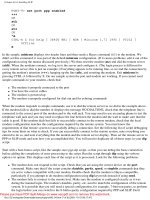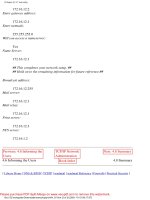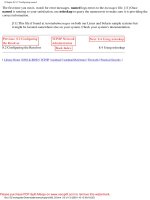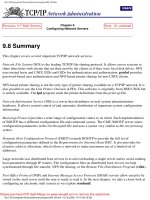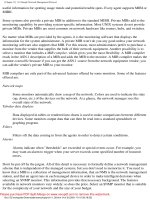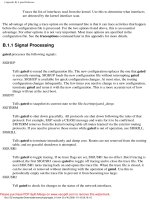Tài liệu Thesis "Neural Network Control" doc
Bạn đang xem bản rút gọn của tài liệu. Xem và tải ngay bản đầy đủ của tài liệu tại đây (2.85 MB, 163 trang )
Thesis
"Neural Network
Control
"
Neural Network Control
Daniel Eggert
24th February 2003
Technical University of Denmark
Informatics and Mathematical Modelling
Building 321, DK-2800 Lyngby, Denmark
Phone +45 4525 3351, Fax +45 4588 2673
www.imm.dtu.dk
IMM-THESIS: ISSN 1601-233X
Abstract
This thesis addresses two neural network based control systems. The first
is a neural network based predictive controller. System identification and
controller design are discussed. The second is a direct neural network con-
troller. Parameter choice and training methods are discussed. Both control-
lers are tested on two different plants. Problems regarding implementations
are discussed.
First the neural network based predictive controller is introduced as an
extension to the generalised predictive controller (GPC) to allow control of
non-linear plant. The controller design includes the GPC parameters, but
prediction is done explicitly by using a neural network model of the plant.
System identification is discussed. Two control systems are constructed for
two different plants: A coupled tank system and an inverse pendulum. This
shows how implementation aspects such as plant excitation during system
identification are handled. Limitations of the controller type are discussed
and shown on the two implementations.
In the second part of this thesis, the direct neural network controller is
discussed. An output feedback controller is constructed around a neural
network. Controller parameters are determined using system simulations.
The control system is applied as a single-step ahead controller to two dif-
ferent plants. One of them is a path-following problem in connection with
a reversing trailer truck. This system illustrates an approach with step-wise
increasing controller complexity to handle the unstable control object. The
second plant is a coupled tank system.
Comparison is made with the first controller. Both controllers are shown
to work. But for the neural network based predictive controller, constr uc-
tion of a neural network model of high accuracy is critical – especially when
long prediction horizons are needed. This limits application to plants that
iii
can be modelled to sufficient accuracy.
The direct neural network controller does not need a model. Instead
the controller is trained on simulation runs of the plant. This requires
careful selection of training scenarios, as these scenarios have impact on the
performance of the controller.
Daniel Eggert
Lyngby,
den 24. februar 2003
iv
Contents
1 Introduction 1
1.1 Overview . . . . . . . . . . . . . . . . . . . . . . . . . . 2
1.2 The Neural Network . . . . . . . . . . . . . . . . . . . . 2
1.2.1 The Two-Layer perceptron . . . . . . . . . . . . . 2
1.2.2 Training . . . . . . . . . . . . . . . . . . . . . . 4
2 Neural Network Model Based Predictive Control 7
2.1 Generalised Predictive Control . . . . . . . . . . . . . . . 8
2.1.1 The Control Law for Linear Systems . . . . . . . 9
2.1.2 Non-linear Case . . . . . . . . . . . . . . . . . . 10
2.1.3 Time Series Prediction with Neural Networks . . . 13
2.2 System Identification . . . . . . . . . . . . . . . . . . . . 16
2.2.1 Error Function . . . . . . . . . . . . . . . . . . . 17
2.2.2 Error Back-propagation . . . . . . . . . . . . . . 18
2.2.3 Pre-processing and post-processing . . . . . . . . 20
2.2.4 Model order selection . . . . . . . . . . . . . . . 21
2.2.5 Regularisation . . . . . . . . . . . . . . . . . . . 22
2.2.6 Neural Network Training . . . . . . . . . . . . . 22
2.3 Implementation of the Coupled Tank System Controller . 24
2.3.1 System Description . . . . . . . . . . . . . . . . 24
2.3.2 System Identification . . . . . . . . . . . . . . . . 25
2.3.3 Performance . . . . . . . . . . . . . . . . . . . . 31
2.3.4 Discussion . . . . . . . . . . . . . . . . . . . . . 38
2.4 Implementation of the Acrobot Controller . . . . . . . . . 38
2.4.1 System Description . . . . . . . . . . . . . . . . 39
2.4.2 System Identification . . . . . . . . . . . . . . . . 41
v
2.4.3 Performance . . . . . . . . . . . . . . . . . . . . 46
2.4.4 Discussion and Improvements . . . . . . . . . . . 48
2.5 Chapter Discussion . . . . . . . . . . . . . . . . . . . . . 51
3 Direct Neural Network Control 53
3.1 Controller Design . . . . . . . . . . . . . . . . . . . . . . 53
3.1.1 Model order selection . . . . . . . . . . . . . . . 54
3.1.2 Neural Network Training . . . . . . . . . . . . . 56
3.2 Implementation of the Reversing Trailer Truck . . . . . . 58
3.2.1 System Description . . . . . . . . . . . . . . . . 58
3.2.2 Bezier Path Implementation . . . . . . . . . . . . 62
3.2.3 Training the Neural Network . . . . . . . . . . . 65
3.2.4 Performance . . . . . . . . . . . . . . . . . . . . 72
3.2.5 Re-training the Neural Network . . . . . . . . . . 80
3.2.6 Performance, revisited . . . . . . . . . . . . . . . 81
3.2.7 Discussion . . . . . . . . . . . . . . . . . . . . . 81
3.3 Implementation of the Coupled Tank System . . . . . . . 83
3.3.1 Neural Network Training . . . . . . . . . . . . . 83
3.3.2 Performance . . . . . . . . . . . . . . . . . . . . 85
3.3.3 Discussion . . . . . . . . . . . . . . . . . . . . . 87
3.4 Chapter Discussion . . . . . . . . . . . . . . . . . . . . . 87
4 Conclusion 89
4.1 Neural Network Model Based Predictive Controller . . . . 89
4.2 Direct Neural Network Controller . . . . . . . . . . . . . 90
4.3 Future Work . . . . . . . . . . . . . . . . . . . . . . . . 92
A Matlab Source Code 95
A.1 Neural Network Model Based Predictive Control . . . . . 95
A.1.1 wb.m . . . . . . . . . . . . . . . . . . . . . . . . 95
A.1.2 runsim.m . . . . . . . . . . . . . . . . . . . . . . 97
A.1.3 plant.m . . . . . . . . . . . . . . . . . . . . . . . 100
A.1.4 pcontrol.m . . . . . . . . . . . . . . . . . . . . . 104
A.1.5 plantmodel.m . . . . . . . . . . . . . . . . . . . 107
A.1.6 nnmodel.m . . . . . . . . . . . . . . . . . . . . . 110
vi
A.1.7 createtrainset.m . . . . . . . . . . . . . . . . . . 116
A.1.8 sqwave.m . . . . . . . . . . . . . . . . . . . . . . 117
A.1.9 humantime.m . . . . . . . . . . . . . . . . . . . 118
A.1.10 variations.m . . . . . . . . . . . . . . . . . . . . 118
A.2 Direct Neural Network Control . . . . . . . . . . . . . . 120
A.2.1 wb.m . . . . . . . . . . . . . . . . . . . . . . . . 120
A.2.2 scalar2weights.m . . . . . . . . . . . . . . . . . . 124
A.2.3 weights2scalar.m . . . . . . . . . . . . . . . . . . 124
A.2.4 fmincost.m . . . . . . . . . . . . . . . . . . . . . 125
A.2.5 runsim.m . . . . . . . . . . . . . . . . . . . . . . 127
A.2.6 lagnnout.m . . . . . . . . . . . . . . . . . . . . . 130
A.2.7 nnout.m . . . . . . . . . . . . . . . . . . . . . . 131
A.2.8 plant.m . . . . . . . . . . . . . . . . . . . . . . . 132
A.2.9 sd2xy.m . . . . . . . . . . . . . . . . . . . . . . . 140
A.2.10 bezierinit.m . . . . . . . . . . . . . . . . . . . . 140
A.2.11 bezierxy.m . . . . . . . . . . . . . . . . . . . . . 145
A.2.12 bezierxyd.m . . . . . . . . . . . . . . . . . . . . 146
A.2.13 bezierxydd.m . . . . . . . . . . . . . . . . . . . . 147
A.2.14 bezierlength.m . . . . . . . . . . . . . . . . . . . 148
A.2.15 beziercurvature.m . . . . . . . . . . . . . . . . . 148
Bibliography 151
Index 153
vii
viii
Chapter 1
Introduction
The present thesis illustrates application of the feed-forward network to
control systems with non-linear plants. This thesis focuses on two concep-
tually different approaches to applying neural networks to control systems.
Many areas of control systems exist, in which neural networks can be
applied, but the scope of this thesis limits the focus to the following two
approaches.
The first application uses the neural network for system identification.
The resulting neural network plant model is then used in a predictive con-
troller. This is discussed in chapter 2.
The other control system uses neural networks in a very different way. No
plant model is created, but the neural network is used to directly calculate
the control signal. This is discussed in chapter 3.
Both chapters discuss theoretic aspects and then try to apply the control
system to two separate plants.
Is is important to note that this thesis is not self-contained. Many aspects
are merely touched upon and others are not at all covered here. Instead this
thesis tries to give an overall picture of the two approaches and some of
their forces and pitfalls.
Due to the limited scope of this thesis, no attempt has been made to dis-
cuss the issues of noise in conjunction with the described control systems.
We assume that the data sources are deterministic.
Likewise the stability of presented controllers will not be discussed either.
Finally, it is worth noting that the plants used throughout this thesis
are merely mathematical models in form of ordinary differential equations
1
Chapter 1 Introduction
(ODEs). All runs of the system are exclusively done by simulation on a
computer – even when this is not mentioned explicitly.
1.1 Overview
After a list of used symbols, this chapter will briefly summarise the kind of
neural network used in this thesis.
Then chapter 2 and chapter 3 each discuss one controller type. All find-
ings are then discussed in chapter 4.
The Matlab source files written for this thesis can be found in appendix A.
1.2 The Neural Network
Throughout this thesis we are using the two-layer feed-forward network
with sigmoidal hidden units and linear output units.
This network structure is by far the most widely used. General concepts
translate to other network topologies and structures, but we will limit our
focus to this network and shortly summarise its main aspects.
1.2.1 The Two-Layer perceptron
The neural network used in this thesis has a structure as sketched in fig-
ure 1.1.
The d input units feed the network with signals, p
i
. Each of the M
hidden units receive all input signals – each of them multiplied by a weight.
The summed input a
j
of the jth hidden unit is calculated from the input
signals as follows:
a
j
=
d
i=0
w
ji
p
i
(1.1)
where p
i
, 1 ≤ i ≤ d are the inputs and p
0
:= 1, so that w
j0
is the bias of
the jth hidden unit. In this way we absorb the bias into the weights.
The activation of the jth hidden unit is g(a
j
) where g(·) is the hidden
unit activation function.
2
1.2 The Neural Network
p
2
p
1
W
kM
p
d
x
k
w
Md
w
M2
w
M1
w
2d
w
22
w
21
W
k2
x
1
w
1d
w
12
w
11
W
12
W
1M
W
k1
W
11
Figure 1.1: The two-layer perceptron with d inputs, M hidden units and k
outputs.
In the same way the activation of the kth output unit is
x
k
=
˜
g
M
j=0
W
kj
· g(a
j
)
(1.2)
Also here we have absorbed the bias into the weights, by setting g(a
0
) := 1
which results in W
k0
being the bias for the kth output unit.
By inserting (1.1) into (1.2) we get
x
k
=
˜
g
M
j=0
W
kj
· g
d
i=0
w
ji
p
i
(1.3)
We will be using a sigmoidal activation function: the hyperbolic tangent
tanh plotted in figure 1.2, for the hidden units:
g(a
j
) ≡ tanh(a
j
) ≡
e
a
j
− e
−a
j
e
a
j
+ e
−a
j
(1.4)
3
Chapter 1 Introduction
-6 -4 -2 0 2 4 6
-2
-1. 5
-1
-0. 5
0
0.5
1
1.5
2
Figure 1.2: The hyperbolic tangent that is used as activation function for
the hidden units.
and a linear activation function for the output units:
˜
g(
˜
a
k
) ≡
˜
a
k
such that the kth output x
k
is given by
x
k
=
M
j=0
W
kj
· tanh
d
i=0
w
ji
p
i
(1.5)
The network with the functional mapping (1.5) maps a multi-variable in-
put into a multi-variable output. Any functional continuous mapping can
be approximated by this neural network to an arbitrary precision provided
the number of hidden units M is sufficiently large.
1.2.2 Training
The process of tuning the neural network weights in order to achieve a
certain kind of performance of the neural network is called training.
4
1.2 The Neural Network
In general, some kind of error function E is specified, and the training
algorithm will search for the weights that result in a minimum of the error
function.
The two conceptually different approaches of applying a neural network
to a control context in chapter 2 and 3 respectively, result in two very dif-
ferent error functions and hence two different training approaches. Each of
these are discussed in the mentioned chapters.
5
6
Chapter 2
Neural Network Model Based
Predictive Control
The aim of controller design is to construct a controller that generates con-
trol signals that in turn generate the desired plant output subject to given
constraints.
Predictive control tries to predict, what would happen to the plant out-
put for a given control signal. This way, we know in advance, what effect
our control will have, and we use this knowledge to pick the best possible
control signal.
What the best possible outcome is depends on the given plant and situ-
ation, but the general idea is the same.
An algorithm called generalised predictive control was introduced in [1] to
implement predictive control, and we will summarise some of it below in
section 2.1.
The algorithm is based on the assumption that the plant can be modelled
with a linear model. If this is not the case, we can use a non-linear model
of the plant to do the prediction of plant outputs. This chapter deals with
using a neural network model of the plant to do predictive control.
First we discuss the linear case of predictive control. Then aspects of
modelling of the plant with a neural network are investigated. This is also
referred to as system identification. Section 2.3 looks into implementation
of the algorithm for a coupled tank system, and section 2.4 discusses the
implementation for an inverse pendulum, the so-called acrobot.
7
Chapter 2 Neural Network Model Based Predictive Control
2.1 Generalised Predictive Control
The generalised predictive control (GPC) is discussed in [1] [2]. It is a
receding horizon method. For a series of projected controls the plant output
is predicted over a given number of samples, and the control strategy is
based upon the projected control series and the predicted plant output.
We will shortly summarise some of the features of the GPC but refer
to [1] [2] for a more detailed discussion.
The objective is to find a control time series that minimises the cost
function
J
GPC
= E
N
2
j=1
(
y(t + j) − r(t + j)
)
2
+ ρ ·
N
2
j=1
(
∆u(t + j − 1)
)
2
(2.1)
subject to the constraint that the projected controls are a function of avail-
able data.
N
2
is the costing horizon. ρ is the control weight. The expectation
of (2.1) is conditioned on data up to time t.
The plant output is denoted y, the reference r, and the control signal u.
∆ is the shifting operator 1 − q
−1
, such that
∆u(t) = u(t) − u(t − 1)
The first summation in the cost function penalises deviation of the plant
output y(t) from the reference r(t) in the time inter val t + 1 ≤ t ≤
t + N
2
. The second summation penalises control signal change ∆u(t) of
the projected control series.
We will furthermore introduce the so-called control horizon N
u
≤ N
2
.
Beyond this horizon the projected control increments ∆u are fixed at zero:
∆u(t + j − 1) = 0, j > N
u
The projected control signal will remain constant after this time. This is
equivalent to placing an effectively infinite weight on control changes for
t > N
u
. Small values of N
u
generally result in smooth and sluggish actu-
ations, while larger values provide more active controls. The use of a control
8
2.1 Generalised Predictive Control
horizon N
u
< N
2
reduces the computation burden. In the non-linear cast
the reduction is dramatic. [1]
2.1.1 The Control Law for Linear Systems
Let us first derive the control law for a linear system, that can be modelled
by the CARIMA model
1
A(q
−1
)y(t) = q
−1
B(q
−1
)u(t) + C(q
−1
)ξ(t)/∆ (2.2)
where ξ(t) is an uncorrelated random sequence.
We introduce
y
N
=
[
y(t + 1), y(t + 2), . . . , y(t + N
2
)
]
T
(2.3)
w =
[
r(t + 1), r(t + 2), . . . , r(t + N
2
)
]
T
(2.4)
˜
u =
[
∆u(t), ∆u(1 + 2), . . . , ∆u(t + N
2
− 1)
]
T
(2.5)
and let y
t
represent data up to time t. We now note, that
J = E
y
N
− w
2
+ ρ∆u
2
y
t
=
ˆ
y
N
− w
2
+ ρ
˜
u
2
+ σ (2.6)
where in turn
ˆ
y
N
= E
{
y
N
|
˜
u, y
t
}
(2.7)
In linear case σ is independent of
˜
u and y
N
, and when minimising the
cost function, σ constitutes a constant value that can be ignored. We can
separate ˆy
N
into two terms: [1]
ˆy
N
= G
˜
u + f (2.8)
where f is the free response, and G
˜
u is the forced response.
The free response is the response of the plant output as a result of the
current state of the plant with no change in input. The forced response is
1
The Controlled Auto-Regressive and Moving-Average model is used in [1].
9
Chapter 2 Neural Network Model Based Predictive Control
the plant output due to the control sequence
˜
u. The linearity allows for this
separation of the two responses.
The important fact is that f depends on the plant parameters and y
t
(i.e. past values of u and y) while the matrix G only depends on the plant
parameters. G does not change over time, and f can be computed very
efficiently.
2,3
Using (2.6) and (2.8) we now have
J =
ˆ
y
N
− w
2
+ ρ
˜
u
2
= G
˜
u + f − w
2
+ ρ
˜
u
2
= (G
˜
u + f − w)
T
(G
˜
u + f − w) + ρ
˜
u
T
˜
u (2.9)
The minimisation of the cost function on future controls results in the
following control increment vector: [1]
min
˜
u
J =
˜
u
∗
= (G
T
G + ρI)
−1
G
T
(wf) (2.10)
and in the following current control signal:
u(t) = u(t − 1) +
¯
g
T
(w − f) (2.11)
where
¯
g
T
is the first row of (G
T
G + ρI)
−1
G
T
.
2.1.2 Non-linear Case
If the plant is non-linear, the cost function (2.1) / (2.6) remains the same,
but implementation of the algorithm is done in a different way.
4
Especially the prediction of the plant outputs ˆy
N
based on the projected
control series
˜
u can not be done in the same way.
For a non-linear plant the prediction of future output signals can not be
found in a way similar to (2.8): The relation of the control signal series to
2
Note that we let y
t
denote all data up to time t.
3
The matrix G and the vector f are defined in [1].
4
Note that σ in equation (2.6) is not independent of
˜
u nor y
N
for a non-linear plant. We
will however assume that the effects of σ are small and can be ignored.
10
2.1 Generalised Predictive Control
the plant output series is non-linear, i.e. the multi-variable function f, that
fulfils
ˆy
N
= f(y
t
,
˜
u) (2.12)
is non-linear. Therefore we can not separate the free response from the
forced response.
5
To solve this problem we need to implement the prediction of y
N
, i.e. f
in (2.12) in a different way. We need a non-linear predictor ˆy
N
for future
plant outputs.
This is where the neural network comes into play: We will facilitate the
neural network to the workings of the function f in (2.12) to obtain the
predictions ˆy
N
. We will train a neural network to do a time series prediction
of plant outputs ˆy
N
for a given control signal time series
˜
u. This will let us
evaluate the GPC cost function (2.1) for a non-linear plant.
Using a suitable optimisation algorithm on the projected control signal
series with respect to the cost function, we find a control series, that min-
imises the cost function:
min
˜
u
J =
˜
u
∗
(2.13)
The complete control algorithm iterates through these three steps:
• choose (a new) control change time series
˜
u
• predict plant output times series ˆy
• calculate cost function J
That is, first we choose a control time series
˜
u. Using a model we look at
what would happen if we choose this series of control signals: we predict
the plant output ˆy. Then we use a cost function (2.1) to tell us how good or
bad the outcome is. Then we let the optimisation algorithm choose a new
control time series
˜
u that is better by means of the cost function (2.1). We
iterate these steps in order to find a series of control signals that is optimal
with respect to the cost function (2.1).
There are 3 distinctive components in this controller:
5
See (2.3) and (2.5) for signal definitions.
11
Chapter 2 Neural Network Model Based Predictive Control
• time series predictor of plant outputs
• cost function
• optimisation algorithm
The cost function is given by (2.1). For the optimisation algorithm we
can use a simplex method which is implemented as a Matlab built-in func-
tion, such as fminsearch.
As we shall see below in section 2.1.3, the time series predictor will use a
neural network model of the plant.
The complete system diagram is sketched in figure 2.1. The neural net-
work model runs alongside the real plant and is used by the controller as
discussed above to predict plant outputs to be used by the controller’s op-
timisation algorithm.
plant
model
u
y
r
^
y
controller
Figure 2.1: The neural network based predictive controller
Control Horizon
As noted earlier in section 2.1, the control horizon N
u
≤ N
2
limits the
number of projected control signal changes such that
∆u(t + j − 1) = 0, j > N
u
If we set the control horizon to some value N
u
< N
2
, the optimiser
will only work on a series of N
u
projected control signal changes, while
evaluating a predicted plant output series that has N
2
samples.
12
2.1 Generalised Predictive Control
Reducing N
u
will dramatically reduce the computational burden, as it
effectively reduces the dimension of the multi-dimensional variable that the
optimiser works on.
2.1.3 Time Series Prediction with Neural Networks
The purpose of our neural network model is to do time series prediction
of the plant output. Given a series of control signals
˜
u and past data y
t
we
want to predict the plant output series y
N
(Cf. equations (2.3)-(2.5)).
We will train the network to do one-step-ahead prediction, i.e. to predict
the plant output y
t+1
given the current control signal u
t
and plant output
y
t
. The neural network will implement the function
ˆ
y
t+1
= f(u
t
, y
t
) (2.14)
As will be discussed below, y
t
has to contain sufficient information for this
prediction to be possible.
6
To achieve multi-step-ahead prediction of all the plant outputs in (2.12)
we will cycle the one step ahead prediction back to the model input. In this
manner, we get predicted signals step by step for time t+1, t+2, . . . t+n.
7
One problem is that this method will cause a rapidly increasing diver-
gence due to accumulation of errors. It therefore puts high demands on
accuracy of the model. The better the model matches the actual plant the
less significant the accumulated error.
A sampling time as large as possible is an effective method to reduce the
error accumulation as it effectively reduces the number of steps needed for
a given time horizon.
The neural network trained to do one-step-ahead prediction will model
the plant. The acquisition of this model is also referred to as system identi-
fication.
6
We assume that y
t
is multi-variable.
7
It is possible to train neural networks to take the control signal time series (u
t
, u
t+1
, . . .)
as inputs and then output the complete resulting time series of plant outputs (2.12) in
one go. It must be noted, though, that the demands on training data increase dramat-
ically with increasing time series length n (curse of dimensionality). Furthermore, one
might argue that if in fact training data of sufficient size was available this data could
train a one step ahead network model to perform equally well.
13
Chapter 2 Neural Network Model Based Predictive Control
Network inputs
In order to predict the plant output, the network needs sufficient informa-
tion about the current state of the plant and the current control signal.
While this state information has to be sufficient to express the state of
the plant, it is at the same time desirable to keep the number of states at
a minimum: A larger number of states will increase the number of inputs
and outputs of the neural network, which in turn will dramatically increase
demands on the training data set size.
If we have a mathematical formula of the plant of the form
˙
Y = f(Y) (2.15)
where Y is a vector of physical parameters, it is apparent that if we choose
Y as our state vector, we will have sufficient information. If furthermore Y
contains no redundant information, we must assume that no other states
will describe the plant using fewer parameters.
Our network model can now be made to predict those states and we will
feed the states back to the neural network model inputs. In this case, the
neural network inputs are the (old) states Y and the control signal, u, as
illustrated in figure 2.2.
For this to work we must be able to extract the state information from the
plant in order to create our training data set. While this is not a problem
when working with mathematical models in a computer, it will be a rare
case in real life. The states in a description such as (2.15) can be difficult to
measure.
A different approach is to use a lag network of control signals and plant
outputs. If no state model (2.15) for the plant is known, this approach is
feasible. The lag network has to be large enough for the network to extract
sufficient information about the plant state.
We still want to keep the network inputs at a minimum since the de-
mands on the training set size grow exponentially with the number of in-
puts. The size of the lag network, however, may have to be quite large in
order to contain sufficient information.
We can effectively reduce the number of input nodes while still being
able to use a sufficiently large lag network, by using principal component
14
2.1 Generalised Predictive Control
plant
model
Y
^
Y
Y
t-1
controller
u
Figure 2.2: Feeding the plant states as an input to the plant model. The
plant outputs its states Y, and those are delayed and fed into the
neural network model of the plant, that will then be able to pre-
dict the plant output. During time series prediction, the output
of the model itself will be fed back into its own input in order
to do multi-step-ahead prediction as described in section 2.1.3.
15
Chapter 2 Neural Network Model Based Predictive Control
analysis on the lag network outputs. Only a subset of the principal com-
ponents is then fed into the neural network. This is discussed below as a
part of pre-processing.
The input to the neural network would then consist of some linear com-
binations of past and present control signals and plant outputs, i.e. some
linear combinations of
(u
t−1
, u
t−2
, . . . , y
t
, y
t−1
, . . . , r
t
, . . .). (2.16)
The above concepts are unified in [3] by using a so called regressor. This
regressor-function ϕ(·, ·) maps the known data (2.16) into a regressor ϕ
t
of fixed dimension:
ϕ
t
= ϕ(u
t−1
, u
t−2
, . . . , y
t
, y
t−1
, . . . , r
t
, . . .)
The regressor ϕ is then used as input to the neural network.
8
2.2 System Identification
As noted above, we want the neural network to predict the plant states one
time step ahead:
ˆ
Y
t+1
= E
Y
t+1
Y
t
, u
t
(2.17)
As noted above in section 7, we assume that Y
t
contains sufficient inform-
ation to describe the current state of the plant.
Or said in a different way, we want the neural network to implement the
function f in
Y
t+1
= f(Y
t
, u
t
) + σ
t
(2.18)
where σ
t
is random noise.
To train the network, we use a data set that we obtain by simulation.
During this simulation, the input signal needs to be chosen with care to
assure that all frequencies and all amplitudes of interest are represented in
this input signal as noted in [4].
8
The regressor can also be used to incorporate some other aspects of pre-processing men-
tioned in section 2.2.3.
16




